Again, we’re at an impasse on the art of the followup. Rising Action was awesome. 1831 was also awesome, but the show must go on by now, right? At some point, we do need to address what happens to the Pantheon now that they’re without a guide (however evil that guide was). But restarting the engines can’t be easy, and I’m not even talking from the obnoxious technical viewpoint of an English major. Take away the aspect of deities and celebrities and you get youths like you or I (not quite, I just turned 28). These characters essentially took their emancipation by force, for sheer survival. The endgame is yet unknown, but it’s ultimately the closest thing these characters will get to adulthood.
All arcs followed a coherence, a core dynamic. The Faust Act was the introduction to the Popstar Gods. Fandemonium was the inner dissent on their mortality. Commercial Suicide was the underlying mechanism of Ananke’s deathly scheme. Rising Action was the retribution for the ‘sins of their elder’. Now, we’re on the threshold of a new arc, a pressing necessity for maturity. There must always be calm before the storm, reflection before the deed. The Imperial Phase arc starts now.
This review will be different than the ones I usually write. And that’s because this issue is different in just about every way. Will the entirety of the arc be like this? Christ, no! Uniqueness and moderation, if not outright scarceness, makes things special. And this is special, all right, as the issue breaks narrative and form with a very clear intent: to bring a dose of realism into a fantasy world. The blood is dry now; it’s time for an interview.
Issue #23
Pantheon Monthly
This issue doesn’t read like a comic. Instead it takes on the form of a showbiz magazine. As such, you can expect advertisements of products, of course, featuring the Gods. It’s worth noting that this issue contains an index, which already kind of says the whole of it. This “Pantheon Monthly” consists of in-universe interviews of the Gods after the events of Issue #22. The comic’s writer himself, Kieron Gillen, functions as the magazine’s editor and ends his role in this issue through an editorial note detailing the outlook after Ananke’s death. He won’t be doing any further writing this time, as the role is filled by a different pen on each interview. Some of these names may sound familiar; that’s because these real-life writers actually lent their pens to the process. In his tumblr, Kieron acknowledges this involved a great deal of role-playing.
The guest artist for this issue is Kevin Wada, who is acknowledged in this universe as the talented photographer whose work illustrated the magazine. This allows us to look at the characters in new stylistic perspectives. The overall effect is suspension of disbelief incarnate. As for the writing itself, it would do everyone a disservice for me to do more than paraphrase the gist of the interviews. The penmanship of these real-life journalists and critics cannot be properly expressed through a recap and review. I strongly advise you, lovely reader, to acquire this issue to properly taste each individual style.
Killing Cities in a Night
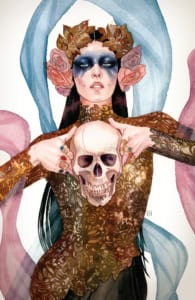 The first interview may just be the in-universe reason for this issue’s existence. The Morrigan, a famously reclusive Goddess, has decided to come into the light and speak her mind for the first time ever. The interviewer is The Guardian‘s Leigh Alexander. For her description of the atmosphere of the Underground and The Morrigan’s very presence, Alexander has a very firm handle on poetics, which shines through phrases like “she’s every raven on the Tower of London, birds raised on the blood of beheaded brides and love betrayed.” Naturally this is a proper mirror to The Morrigan’s own discourse. As for the tri-God, she speaks on her troubled relationship to the past as well as with her own identity, both as a God and as a human being.
The first interview may just be the in-universe reason for this issue’s existence. The Morrigan, a famously reclusive Goddess, has decided to come into the light and speak her mind for the first time ever. The interviewer is The Guardian‘s Leigh Alexander. For her description of the atmosphere of the Underground and The Morrigan’s very presence, Alexander has a very firm handle on poetics, which shines through phrases like “she’s every raven on the Tower of London, birds raised on the blood of beheaded brides and love betrayed.” Naturally this is a proper mirror to The Morrigan’s own discourse. As for the tri-God, she speaks on her troubled relationship to the past as well as with her own identity, both as a God and as a human being.
When questioned about why she asked for an interview, The Morrigan declares she’d have something more solid to survive her than just her reputation. In alignment with her impenetrably mysterious persona, she may intend this to shed further obscurity on her already enigmatic design. As for more concrete matters, she discusses Baphomet, her captivity, and how her feeling of responsibility for him led to the latter. These events certainly didn’t endear her to the world outside of the Underground. In the wake of Ananke’s death, she decides she’ll live as well as she can. All the while, she’ll maintain the sacredness of the Underworld, for her and those who come to visit.
A Whole New Baal Game
The Guardian‘s Dorian Lynskey is the one to interview Baal. The Thunder God’s current persona is all he’s previously been, with a new touch of leadership and maturity. This one takes place at the new Pantheon HQ, the Shard. In spite of his undying swagger, he expresses a sense of responsibility for his peers at the conclusion of Ananke’s plan. This is certainly fitting, given his previous role at her side as loyal, blinded tool. Something else that hadn’t been fleshed out before was his seniority. He was basically the ‘firstborn’, so he’ll also be the first to die. Thus he sees it as his duty to make sure things are in order. Naturally, this involves a lot of PR.
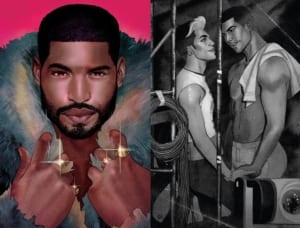
In spite of Baal’s charismatic nonchalance on the subject of guilt, the interviewer doesn’t entirely believe him. As you’d expect, this involves the subject of his beating of The Morrigan and poor judgement about Ananke. Industriousness appears as a way to temper his ego, making him humbler, in a way. Perhaps that is a means of redemption. Nonetheless, his perspective on the future is his relationship with Persephone, being a good father figure to Minerva. And he’s also looking into saving the world, whatever that might entail.
Sympathy for the Nice Guy
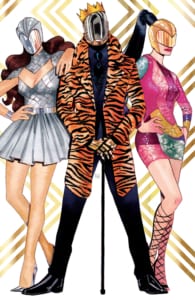 Feminist columnist and author Laurie Penny got the short straw for this one. She’s interviewing Woden, which sounds so delightful I need say no more to stress how bad a match this is. It’s also quite bitterly humourous. Most of Woden’s discourse is parent-blaming and self pity. Truly, the shining gem in this one is not actually Woden. Overall, he’s a one trick pony and you know you can safely expect pretentious verbal villainy out of him. However, the interviewer is more than competent to know how to lead his word vomit into a line of dialogue.
Feminist columnist and author Laurie Penny got the short straw for this one. She’s interviewing Woden, which sounds so delightful I need say no more to stress how bad a match this is. It’s also quite bitterly humourous. Most of Woden’s discourse is parent-blaming and self pity. Truly, the shining gem in this one is not actually Woden. Overall, he’s a one trick pony and you know you can safely expect pretentious verbal villainy out of him. However, the interviewer is more than competent to know how to lead his word vomit into a line of dialogue.
However, there are some things worth extrapolating from the interview format for further consideration. Whereas the two previous interviews were more focused on the characters, this one outright expresses that Woden is terrified of Persephone. The fact that he didn’t actually agree to complicity in Ananke’s killing with the rest may hint at trouble in the horizon. He’s also working on a new project, and with him that never bodes well. As an end to the interview, Woden remarks that he is a huge fan of Game of Thrones. Is anybody surprised? No, anyone?
I Saw You Kissing Satan Claus
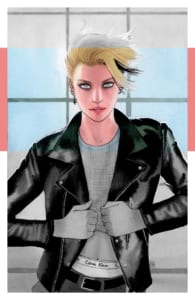 This is a posthumous interview with Lucifer by prolific writer and journalist Mary HK Choi. The interview had been withheld for legal reasons, as this one took place on the Christmas just before her death. This interview is cryptic but not as The Morrigan’s was; rather, this one is troublesome in terms of pacing, digressions and response, which hint at Lucifer’s emotional state or overall fatalistic persona. Nonetheless, she still discusses her relationships with Sakhmet and Inanna. In particular, the latter appears to elicit a subtle guilty reaction. While Lucifer is vibrant, and fun to be with, there’s also an edge of sorrow to follow.
This is a posthumous interview with Lucifer by prolific writer and journalist Mary HK Choi. The interview had been withheld for legal reasons, as this one took place on the Christmas just before her death. This interview is cryptic but not as The Morrigan’s was; rather, this one is troublesome in terms of pacing, digressions and response, which hint at Lucifer’s emotional state or overall fatalistic persona. Nonetheless, she still discusses her relationships with Sakhmet and Inanna. In particular, the latter appears to elicit a subtle guilty reaction. While Lucifer is vibrant, and fun to be with, there’s also an edge of sorrow to follow.
Interestingly, the interviewer harbours doubt on the legitimacy of the Pantheon. However, rather than opting for Cassandra’s axis of reasoning on divinity proper, Choi ruminates on the concept of Popstar Gods as possibly manufactured by the music industry. Stranger things have happened, but at least in this universe, we know better by now.
Cloudbusting
The next interview has essayist Ezekiel Kweku interview Amaterasu in San Francisco. Right off the bat, he picks up on Amaterasu’s optimism, not only as Goddess, but as a person. In particular I must remark that Kweku has quite a way to metaphorise this intent by alluding to a ray of undivided sunlight which inevitably hits a prism, illustrating the inescapable nuances of being a human nonetheless. Amaterasu’s line of discourse is perhaps the most in alignment with the role as a God which, in a previous issue, has resulted in problematic implications. Her performances and deeds as a member of the Pantheon all seem to derive from a predominant willfulness.
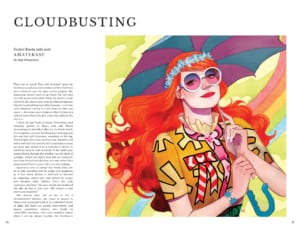
The Sun Goddess discusses her view on Ananke, and even here she is considerably forgiving of the individual herself. She then goes on to talk about her friendship with Lucifer, as well as the murder of Minerva’s parents and the current role of Baal and Urdr as the Pantheon’s “father and mother”. This furthers the notion that Amaterasu is so unironically believing of divinity’s importance that she appears even naive, as a child would. Thus the Pantheon, following the same line of thought, would act as a family to pursue the GREATER GOOD for all. This is a beautiful thought and one we’d like to believe, but we know better.
Death in Valhalla
The interviews end here and we’re treated to a section detailing key events in Ananke’s plan. These include her villainous Bond-villain, hand rubbing monologue, recorded by Owly, and the murder of Minerva’s parents. The final page, as per the coherence and structure of a magazine features each of the individuals responsible for this experimental issue. And really, it’s a beauty, as it still shows an adherence to the format intended. And, of course, a wee comic strip at the very end to send us home with the visual equivalent of a lollipop in our mouths. What is the Pantheon to do after Persephone killed Ananke to save Minerva? Why, they have a party, as you do!
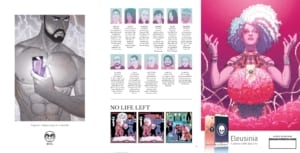
All in all, calling this a clever issue is massive understatement. We know the state of affairs now, so we can swiftly and neatly get back into the action. But, as a closing thought, let’s remember that this issue is the culmination of another scheme. This one is to keep the truth of Ananke’s death at Persephone’s hand a secret. The fact that nobody seems to know she killed the old Goddess, not in self defence or to rescue an already saved Minerva, hints that the rest of the Pantheon abides to Woden’s conditions to withhold the truth. Goes to show Game of Thrones’ fans are the worst, and may prove dangerous as the narrative unfolds.

